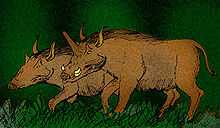Kubanochoerus
| Kubanochoerus Temporal range: Miocene | |
|---|---|
 | |
| Skull of K. gigas | |
| Scientific classification | |
| Kingdom: | Animalia |
| Phylum: | Chordata |
| Class: | Mammalia |
| Order: | Artiodactyla |
| Family: | Suidae |
| Genus: | Kubanochoerus |
| Species | |
| |
Kubanochoerus is an extinct genus of large and long-legged pigs from the Miocene of Eurasia.
Description


The largest species, the aptly named K. gigas, grew to be up 1.2 metres (3.9 ft) at the shoulder, and probably weighed up to 500 kilograms (1,100 lb) in life. The heads of these pigs were unmistakable, with small eyebrow horns, and a large horn emanating from the forehead of the males. It is speculated that the males used their forehead horns for jousting with each other.
The species K. massai was originally thought to be an African species belonging to this genus, as the first specimen shared the genus' distinctive eyebrow horns. Its lack of a forehead horn lead experts to interpret the skull as belonging to a female. However, recently, K. massai has been split off into its own genus, Libyochoerus (commemorating the fact that it was originally found in Libya.) Some species of the genus Megalochoerus have been also reassigned to Libyochoerus, though, many experts do not agree with this.
References
- Kubanochoerus in the Paleobiology Database